Unit 2 Understanding each other Workbook Page 63-68课件(共46张PPT)-2025-2026学年译林版(2020)选择性必修第四册
文档属性
| 名称 | Unit 2 Understanding each other Workbook Page 63-68课件(共46张PPT)-2025-2026学年译林版(2020)选择性必修第四册 | 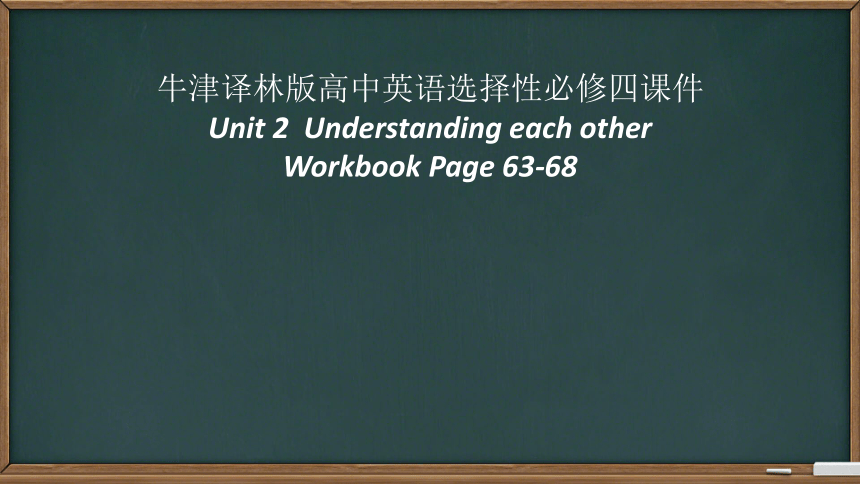 | |
| 格式 | pptx | ||
| 文件大小 | 518.2KB | ||
| 资源类型 | 教案 | ||
| 版本资源 | 牛津译林版(2019) | ||
| 科目 | 英语 | ||
| 更新时间 | 2025-06-17 21:41:05 | ||
图片预览

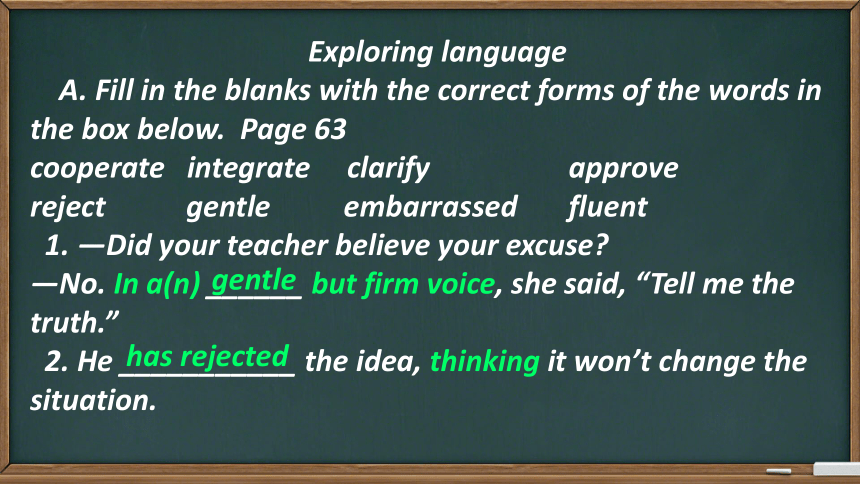
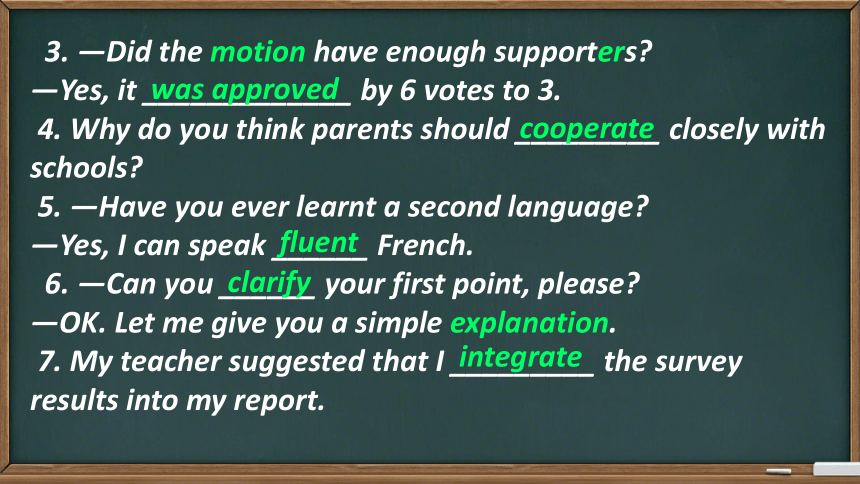
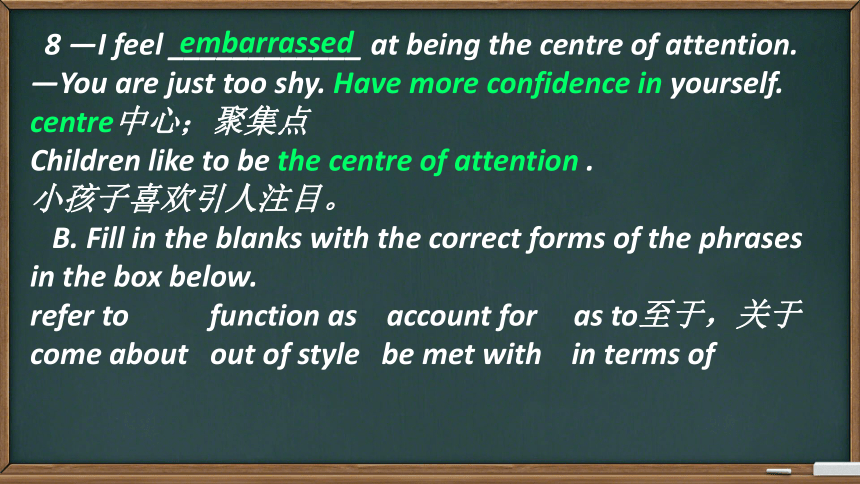
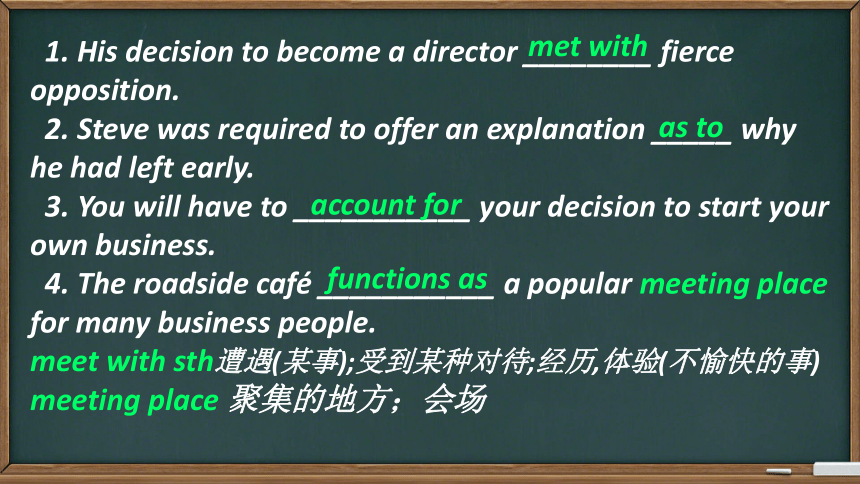
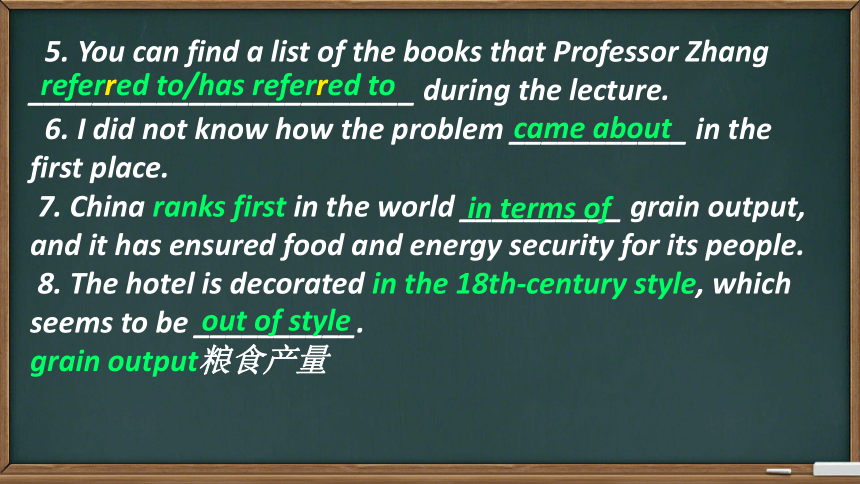
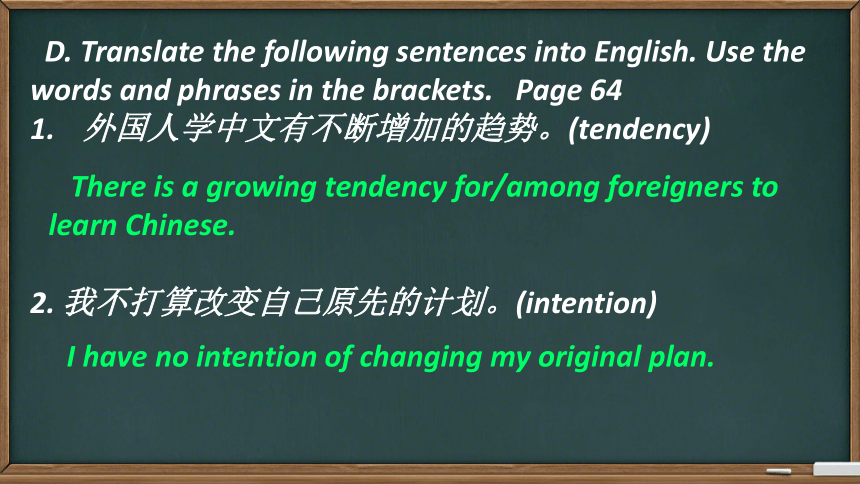

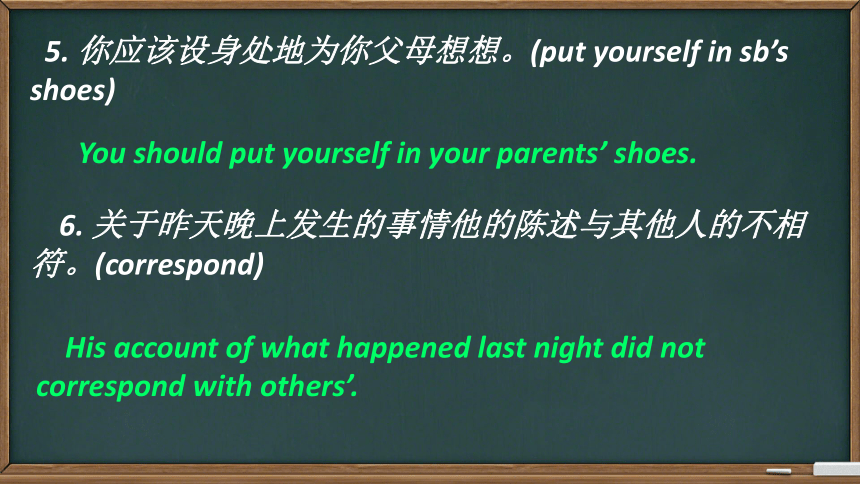
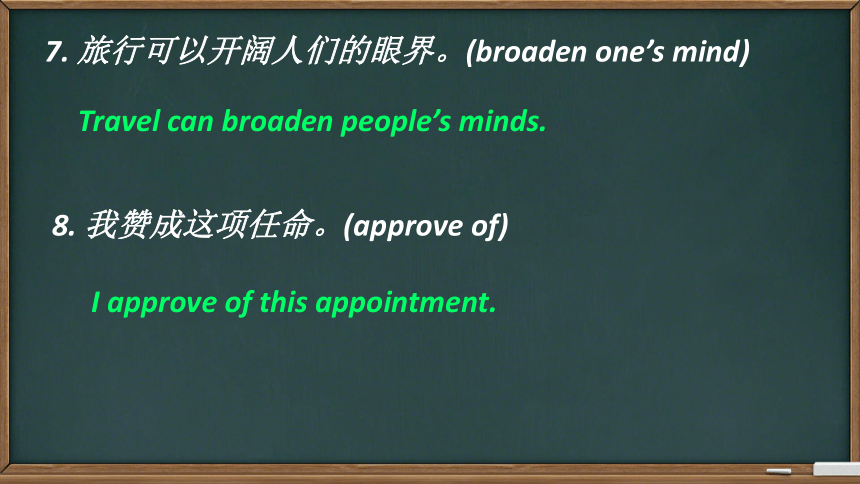
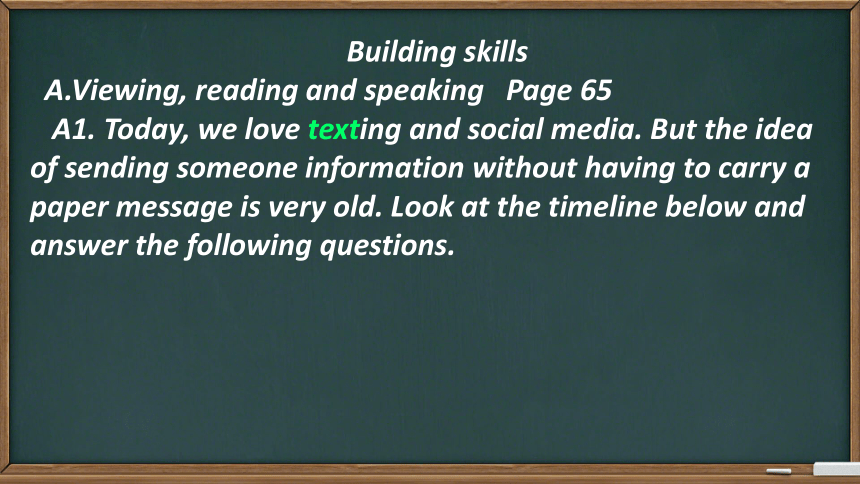
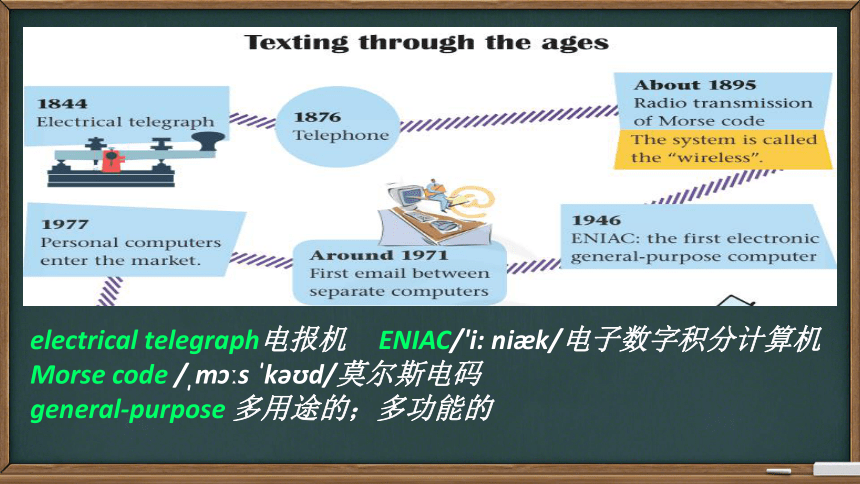
文档简介
(共46张PPT)
牛津译林版高中英语选择性必修四课件
Unit 2 Understanding each other
Workbook Page 63-68
Exploring language
A. Fill in the blanks with the correct forms of the words in the box below. Page 63
cooperate integrate clarify approve
reject gentle embarrassed fluent
1. —Did your teacher believe your excuse
—No. In a(n) ______ but firm voice, she said, “Tell me the truth.”
2. He ___________ the idea, thinking it won’t change the situation.
gentle
has rejected
3. —Did the motion have enough supporters
—Yes, it _____________ by 6 votes to 3.
4. Why do you think parents should _________ closely with schools
5. —Have you ever learnt a second language
—Yes, I can speak ______ French.
6. —Can you ______ your first point, please
—OK. Let me give you a simple explanation.
7. My teacher suggested that I _________ the survey results into my report.
was approved
cooperate
fluent
clarify
integrate
8 —I feel ____________ at being the centre of attention.
—You are just too shy. Have more confidence in yourself.
centre中心;聚集点
Children like to be the centre of attention .
小孩子喜欢引人注目。
B. Fill in the blanks with the correct forms of the phrases in the box below.
refer to function as account for as to至于,关于
come about out of style be met with in terms of
embarrassed
1. His decision to become a director ________ fierce opposition.
2. Steve was required to offer an explanation _____ why he had left early.
3. You will have to ___________ your decision to start your own business.
4. The roadside café ___________ a popular meeting place for many business people.
meet with sth遭遇(某事);受到某种对待;经历,体验(不愉快的事)
meeting place 聚集的地方;会场
met with
as to
account for
functions as
5. You can find a list of the books that Professor Zhang ________________________ during the lecture.
6. I did not know how the problem ___________ in the first place.
7. China ranks first in the world __________ grain output, and it has ensured food and energy security for its people.
8. The hotel is decorated in the 18th-century style, which seems to be __________.
grain output粮食产量
referred to/has referred to
came about
in terms of
out of style
D. Translate the following sentences into English. Use the words and phrases in the brackets. Page 64
外国人学中文有不断增加的趋势。(tendency)
2. 我不打算改变自己原先的计划。(intention)
There is a growing tendency for/among foreigners to learn Chinese.
I have no intention of changing my original plan.
3. 双方协商,最终达成一致。(negotiate)
4. 他似乎反对我想做的任何事。(oppose)
The two sides negotiated and finally reached an agreement.
It seems that he opposes anything I want to do.
5. 你应该设身处地为你父母想想。(put yourself in sb’s shoes)
6. 关于昨天晚上发生的事情他的陈述与其他人的不相符。(correspond)
You should put yourself in your parents’ shoes.
His account of what happened last night did not correspond with others’.
7. 旅行可以开阔人们的眼界。(broaden one’s mind)
8. 我赞成这项任命。(approve of)
Travel can broaden people’s minds.
I approve of this appointment.
Building skills
A.Viewing, reading and speaking Page 65
A1. Today, we love texting and social media. But the idea of sending someone information without having to carry a paper message is very old. Look at the timeline below and answer the following questions.
electrical telegraph电报机 ENIAC/'i: ni k/电子数字积分计算机
Morse code / m s k d/莫尔斯电码
general-purpose 多用途的;多功能的
bulletin board(电子)布告栏 emoti·con / m t k n/ 表情符号
char·ac·ter / k r kt (r)/ 文字,字母,符号
SMS=Short message service短信服务;短消息;(发)短信
emoji / m d i/表情符号;绘文字
1. What information can you get from the above timeline
From the timeline we can see the evolution and development of messaging from the electrical telegraph in 1844 to the use of smartphones in modern day.
mes·sage sb (sth) / mes d / 向(某人)传送(电子信息)
2. Do you think the timeline above is a good way of presenting the information Give reasons.
Yes. The timeline presents the information in a clear way and allows us to get a quick overview of the development of texting. The use of short pieces of information along
with images makes the content more accessible and interesting. Also, since the exact years are given, it is easy for us to research specific topics in more depth.
over·view / v vju / 概述;纵览;概论;概况
in depth全面;深入;详细
A2. In pairs, discuss the future means of communication. Use the example below to help you and pay attention to the expressions in bold. Page 66
A: I wonder what the future of communication will be. Will we still be using smartphones ten years from now
B: Smartphones have only been around for a decade or two. However, technology is developing so fast that we have reason to believe they will be replaced some day. The question is, what will replace them
around出现;现有;可用
A: Personally, I think smartglasses will take their place: they could be voice-activated, and they would display information on top of what we normally see. For instance, we would be able to see text messages passing across our field of vision. That might become a reality in a couple of years.
smartglasses智能眼镜
voice-activated/ v s kt ve t d/声控的;通过声音启动的
ac·ti·vate / kt ve t/ 使活动;激活;使活化
on top of sth/sb在…上面;覆盖着;除…之外;与…紧靠着;控制着;掌握着
nor·mal·ly/ n m li/ 通常;正常情况下;正常地;平常地field of vision视野
B: I think so too. Also, smartglasses could become easily affordable within the next ten years.
A: Yeah, that sounds reasonable. What about the future further ahead
B: I think that a major breakthrough in hologram technology is just around the corner, that is, three-D images. With holograms, video chats can be much more realistic. 逼真的;栩栩如生的
holo·gram / h l ɡr m/ 全息图
(just) around/round the corner很近;在附近
Just imagine that almost everyone could see a three-D image of the person they are talking to online in front of them. I’m sure we’ll see something like that a decade from now.
A: Yeah, that would be amazing. Here’s another of those science fiction dreams that might come true one day: what if we could somehow connect our brains directly to the Internet No more typing or voice controlling—we would instead communicate through thinking!
B: That’s definitely not going to happen in my lifetime. But it’s a really cool idea.
B. Listening and writing
B1. Mr Zhang is giving a lecture about body language in different cultures. Listen to the lecture and decide whether the following statements are true (T) or false (F). If the information is not mentioned in the lecture, circle NG (not given).
body language [ U]身势语,肢体语言(通过姿势等表露思想感情)
sign language 手势语
1. Americans tend to give firm handshakes. T / F / NG
2. Chinese people consider an overly firm handshake rude.
T / F / NG
3. Americans usually avoid direct eye contact while talking to others. T / F / NG
4. Some Africans may be annoyed if you look them straight in the eye. T / F / NG
5. People shake their head for “yes” in some parts of Eastern Europe. T / F / NG
6. People in Southern Europe generally stand further away from strangers in public. T / F / NG
like to have
Tapescript
Mr Zhang: Today, I’ll be talking about body language. Body language and the messages it sends may be different in different cultures. For example, when Americans shake hands, they grasp the other person’s hand quite firmly,
because they think this shows they are strong and can be trusted. However,in some countries of Europe, Asia and Africa, an overly firm handshake is considered rude.
over·ly/ v li/ (用于形容词前)很;十分;过于,=excessively
In the same way, Americans like to look other people straight in the eye when they are talking, because to them this shows that they are telling the truth and are listening carefully. However, in parts of Asia and Africa,people might get anxious or even annoyed if you look them straight in the eye.
We nod our head for “yes” and shake our head for “no”, but these head movements mean the opposite in parts of Eastern Europe.
look sb in the eye(s)/ face(坦然或问心无愧地)直视某人,正视某人
Personal space is another kind of body language that may differ from culture to culture. In some cultures, for instance, Southern Europe and Latin America, people stand closer to each other, and it’s OK to touch each other’s shoulders or arms while speaking. In other cultures, this is considered rude. Also, people in Northern Europe generally stand further away from strangers in public places.
Now, let’s look at how body language can be used to … (Voice fades out.)
personal space个人空间(站立或坐着时与他人保持的距离范围)
fades in/out(画面)淡入/淡出,渐显/渐隐;(声音)渐强/渐弱
B2. Two students are talking about body language after the lecture. Listen to the talk and complete the notes below. P 67
Aspects of body language
Kissing
People in Spain, Italy and France tend to greet others by kissing (1) _____________.
Though people in Europe prefer having more personal space, there is more (2) ________ and kissing.
Shaking hands
In Britain, people mostly shake hands when (3) ___________.
Instead of shaking hands, friends will hug each other while (4) ______________.
on both cheeks
hugging
they meet
saying goodbye
Counting
People in Europe tend to use (5) __________ to count to ten.
Compared with how people count in Spain, the counting system the girl uses is (6) _____________________.
Tapescript
Amy: That lecture about body language was interesting, wasn’t it Did you notice any differences in body language when you went to Australia this summer
two hands
much more convenient
John: Oh, I changed my plan and went to Europe instead. And I did notice that some things were quite different there! Particularly the kissing! People in Spain, Italy and France like to kiss you on both cheeks when they meet you. I didn’t like that. I felt so awkward.
Amy: Oh, how strange!
John: Well, it is, because in general people stay further apart when talking or sitting and they like to have more personal space. But then there is more hugging and
kissing.
Amy: I thought people mostly shook hands when they met
John: Yes, in Britain they do, but if you made friends and then you were saying goodbye, they would give you a hug. Another thing that is different in Britain is how often people say sorry. Even if it is not your fault, it is often expected that you apologize. It seems very strange to me.
Amy: Oh, isn’t it funny how things are different in different cultures
John: Well, the one thing we definitely do better than the Europeans is counting.
Amy: Counting
John: Yes, they use two hands to count to ten! I was trying to ask if there was a train at nine o’clock using my fingers when I was in Spain, but they had no idea what I meant. Then they held up nine fingers on two hands and I realized that was how they counted!
Amy: Oh yes. I agree our system is much more convenient!
B3. Write an article introducing body language. You may use the information in B1 and B2 to help you.
The power of body language
The term “body language” covers a wide range of non-verbal forms of communication. It varies from person to person. People are often unaware of their own body language.
non-verbal 不涉及言语的;非言语的
Human body language can broadly be divided into three main categories: facial expressions and eye movements, gestures, and finally posture and overall movement
patterns. Facial expressions and eye movements are a very important form of non-verbal communication which indicates whether someone is friendly or hostile, and
what mood they are in.
broad·ly / br dli/ 大体上;基本上;不考虑细节地
pos·ture / p st (r)/ (坐立的)姿势;态度;看法;立场;处理方式
hos·tile / h sta l/ 敌意的;敌对的
Gestures are another major type of non-verbal communication.As with facial expressions, gestures can suggest attitude and mood.However, there are differences as well: we usually have more control over our gestures than over other forms of body language, so we can use them to emphasize what we are saying; unlike other types of non-verbal communication, gestures can also express specific meanings.
Posture and movement patterns, finally, are an aspect of body language that we often overlook, as most of it happens unconsciously. The way we stand, sit and move are deep-rooted habits that can be very difficult to change.
over·look / v l k/ 忽略;未注意到
un·con·scious·ly / n k n sli/ 无意地;不知不觉地
deep-rooted/deep-seated 根深蒂固的;强烈的;坚定的
Body language is a crucial part of communication. If we fully understand the role non-verbal communication plays in our daily interactions with others, we will be able to express ourselves more authentically. For example, maintaining an appropriate amount of eye contact shows that you are engaged in the conversation, which makes
the person you are speaking to feel valued.重视;珍视
interaction/ nt r k ( )n/交流;沟通;合作
authentically/ θent kli/真实的;真正地,确实地;可靠地
eye contact目光接触; 对视
en·gaged (in/on sth) / n ɡe d d/ 忙于;从事于
Also, our body language helps put the verbal communication in context and gives others a better idea about our intentions. By smiling or moving in a friendly, non-threatening way, we can show others that we mean
no harm. ver·bal / v bl/ adj. 文字的;言语的;词语的
in context 联系背景地
in·ten·tion / n ten n/ 打算;计划;意图;目的
threat·en·ing / θretn / 威胁的;恐吓的
mean (sb) no harm/not mean (sb) any harm没有恶意;并非出于恶意
Ambiguous body language can make people feel uneasy, and it can also make them confused about what we really mean. It is therefore important to be aware of the signals that our body language sends out, so that we can make sure we express ourselves in a suitable way.
am·bigu·ous / m b ɡju s/ 模棱两可的;含混不清的;不明确的
un·easy / n i zi/ 担心的;忧虑的;不安的;令人不安的;令人不舒服的;不安稳的
send out发出(光、信号、声音等);分发;散发
Appreciating language Page 68
When making a speech, we should deliver our ideas to the audience in a suitable way. Read aloud the essay below about the art of public speaking.
Our next subject will be the style of expression. For it is not enough to know what we ought to say; we must also say it as we ought; much help is thus afforded towards producing the right impression of a speech.我们接下来要讨论的是表达风格问题。因为仅仅知道该说什么是不够的,我们还必须掌握恰当的表述方式—这对塑造演讲的正确印象大有裨益。public speaking 演讲术 afford提供;给予
deliver 发表;宣布;发布;履行诺言;不负所望;兑现
produce引起;导致;使产生
It is plain that delivery has just as much to do with oratory as with poetry.It is, essentially, a matter of the right management of the voice to express the various motions—of speaking loudly, softly or between the two; of high, low or intermediate pitch; of the various rhythms that suit various subjects. 显然,表达技巧对演说的重要性不亚于对诗歌的影响。其本质在于通过声音的恰当调控来传递不同情感:或洪亮,或轻柔,或介于二者之间;或高亢,或低沉,或中等音调;以及适合不同主题的多样节奏。
plain清楚的;明显的;浅白的
delivery /d l v ri/ 演讲方式;表演风格
ora·tory / r tri/ 讲演术;雄辩术 pitch /p t / 音高
inter·medi·ate / nt mi di t/中级的;中等的;适合中等程度者的
These are the three things—volume of sound, changes in pitch,and rhythm—that a speaker bears in mind. It is those who do bear them in mind who usually win prizes in the dramatic contests.音量、音调变化和节奏,正是演说者需要牢记的三大要素。那些真正重视这些技巧的人,往往能在戏剧竞赛中脱颖而出。
dra·mat·ic /dr m t k/ 戏剧的;有关戏剧的;戏剧学的;突然的;巨大的;令人吃惊的;激动人心的;引人注目的;给人印象深刻的
No systematic study of the rules of delivery has yet been made; indeed, even the study of language made no progress till late in the day. Besides, delivery is not regarded as an important subject of inquiry.
目前尚未形成系统的表达规则研究体系——实际上,连语言研究本身也是近代才取得进展的。此外,表达技巧通常不被视为重要研究课题。
sys·tem·at·ic / s st m t k/ 成体系的;系统的;有条理的;有计划有步骤的
inquiry/ n kwa ri/调查; 查究
Still, the whole business of rhetoric being concerned with appearances, we must pay attention to the subject of delivery, unworthy though it is, because we cannot do without it. The right thing in speaking really is that we should be satisfied not to annoy our hearers, without trying to delight them.但既然修辞学整体关乎外在表现,即便这个课题看似微不足道,我们也必须加以重视,因为它不可或缺。演讲的真谛本应是不令听众反感即可,而非刻意取悦。
still /st l/ (虽然…)还是;但;不过
rhet·oric / ret r k/ 修辞技巧;修辞;花言巧语
un·worthy / n w i/ 不值得(尊重)的;不配的
do without (sb/sth)没有…也行;没有…而设法对付过去
satisfied 确信的;信服的
We ought to fight our case with no help beyond the bare facts: nothing, therefore, should matter except the proof of those facts. Still, as has been already said, other things
affect the result considerably, owing to the defects of our hearers.我们本应仅凭事实本身来论证观点:除了事实证据,其他皆无关紧要。然而如前所述,由于听众的局限性,其他因素仍会显著影响效果。
bare 仅够的;最基本的;最简单的
con·sid·er·ably /k n s d r bli/ 非常;很;相当多地
de·fect / di fekt/ 缺点;缺陷;毛病
The arts of language cannot help having a small but real importance, whatever it is we have to expound to others: the way in which a thing is said does affect how easy it is for the hearer to understand it. Not, however, so much importance as people think. 无论阐述什么内容,语言艺术确实具有微小但真实的影响力:表达方式确实会影响听众的理解难度——尽管其重要性常被高估。
art技能;技术;技巧
ex·pound sth (to sb)/on sth / k spa nd/ 详解;详述;阐述
not so much ... as ...(不如…) 那么多
All such arts are meant to charm the hearer. Nobody uses fine language when teaching geometry. /d i m tri/ 几何(学)
When the principles of delivery have been worked out, they will produce the same effect as on the stage. But only very slight attempts to deal with them have been made and by a few people. 这类技巧本质上都是为了取悦听众,正如教授几何学时没人会使用华丽的辞藻。 当表达原则被系统总结后,其效果将不亚于舞台表演。但迄今为止,只有极少数人做过浅尝辄止的尝试。
be meant to be sth被普遍认为是
charm /t ɑ m/ 吸引;迷住
Dramatic ability is a natural gift,and can hardly be systematically taught. The principles of good diction can
be so taught. Therefore, we have men of ability in this direction too as well as those speakers who excel in delivery
—speeches of the written or literary kind owe more of their effect to their direction than to their thought.戏剧天赋是与生俱来的,很难通过系统教学获得;而优秀的措辞原则却可被传授。因此我们既能看到擅长此道的能者,也不乏精于表达的演说家——那些书面化或文学化的演讲,其效果往往更多源于表达方式而非思想深度。
systematically/ s st m t kli/系统地,有条理地
dic·tion / d k n/ 措辞;用语;用词
excel / k sel/ ( -ll- )擅长;善于;突出
牛津译林版高中英语选择性必修四课件
Unit 2 Understanding each other
Workbook Page 63-68
Exploring language
A. Fill in the blanks with the correct forms of the words in the box below. Page 63
cooperate integrate clarify approve
reject gentle embarrassed fluent
1. —Did your teacher believe your excuse
—No. In a(n) ______ but firm voice, she said, “Tell me the truth.”
2. He ___________ the idea, thinking it won’t change the situation.
gentle
has rejected
3. —Did the motion have enough supporters
—Yes, it _____________ by 6 votes to 3.
4. Why do you think parents should _________ closely with schools
5. —Have you ever learnt a second language
—Yes, I can speak ______ French.
6. —Can you ______ your first point, please
—OK. Let me give you a simple explanation.
7. My teacher suggested that I _________ the survey results into my report.
was approved
cooperate
fluent
clarify
integrate
8 —I feel ____________ at being the centre of attention.
—You are just too shy. Have more confidence in yourself.
centre中心;聚集点
Children like to be the centre of attention .
小孩子喜欢引人注目。
B. Fill in the blanks with the correct forms of the phrases in the box below.
refer to function as account for as to至于,关于
come about out of style be met with in terms of
embarrassed
1. His decision to become a director ________ fierce opposition.
2. Steve was required to offer an explanation _____ why he had left early.
3. You will have to ___________ your decision to start your own business.
4. The roadside café ___________ a popular meeting place for many business people.
meet with sth遭遇(某事);受到某种对待;经历,体验(不愉快的事)
meeting place 聚集的地方;会场
met with
as to
account for
functions as
5. You can find a list of the books that Professor Zhang ________________________ during the lecture.
6. I did not know how the problem ___________ in the first place.
7. China ranks first in the world __________ grain output, and it has ensured food and energy security for its people.
8. The hotel is decorated in the 18th-century style, which seems to be __________.
grain output粮食产量
referred to/has referred to
came about
in terms of
out of style
D. Translate the following sentences into English. Use the words and phrases in the brackets. Page 64
外国人学中文有不断增加的趋势。(tendency)
2. 我不打算改变自己原先的计划。(intention)
There is a growing tendency for/among foreigners to learn Chinese.
I have no intention of changing my original plan.
3. 双方协商,最终达成一致。(negotiate)
4. 他似乎反对我想做的任何事。(oppose)
The two sides negotiated and finally reached an agreement.
It seems that he opposes anything I want to do.
5. 你应该设身处地为你父母想想。(put yourself in sb’s shoes)
6. 关于昨天晚上发生的事情他的陈述与其他人的不相符。(correspond)
You should put yourself in your parents’ shoes.
His account of what happened last night did not correspond with others’.
7. 旅行可以开阔人们的眼界。(broaden one’s mind)
8. 我赞成这项任命。(approve of)
Travel can broaden people’s minds.
I approve of this appointment.
Building skills
A.Viewing, reading and speaking Page 65
A1. Today, we love texting and social media. But the idea of sending someone information without having to carry a paper message is very old. Look at the timeline below and answer the following questions.
electrical telegraph电报机 ENIAC/'i: ni k/电子数字积分计算机
Morse code / m s k d/莫尔斯电码
general-purpose 多用途的;多功能的
bulletin board(电子)布告栏 emoti·con / m t k n/ 表情符号
char·ac·ter / k r kt (r)/ 文字,字母,符号
SMS=Short message service短信服务;短消息;(发)短信
emoji / m d i/表情符号;绘文字
1. What information can you get from the above timeline
From the timeline we can see the evolution and development of messaging from the electrical telegraph in 1844 to the use of smartphones in modern day.
mes·sage sb (sth) / mes d / 向(某人)传送(电子信息)
2. Do you think the timeline above is a good way of presenting the information Give reasons.
Yes. The timeline presents the information in a clear way and allows us to get a quick overview of the development of texting. The use of short pieces of information along
with images makes the content more accessible and interesting. Also, since the exact years are given, it is easy for us to research specific topics in more depth.
over·view / v vju / 概述;纵览;概论;概况
in depth全面;深入;详细
A2. In pairs, discuss the future means of communication. Use the example below to help you and pay attention to the expressions in bold. Page 66
A: I wonder what the future of communication will be. Will we still be using smartphones ten years from now
B: Smartphones have only been around for a decade or two. However, technology is developing so fast that we have reason to believe they will be replaced some day. The question is, what will replace them
around出现;现有;可用
A: Personally, I think smartglasses will take their place: they could be voice-activated, and they would display information on top of what we normally see. For instance, we would be able to see text messages passing across our field of vision. That might become a reality in a couple of years.
smartglasses智能眼镜
voice-activated/ v s kt ve t d/声控的;通过声音启动的
ac·ti·vate / kt ve t/ 使活动;激活;使活化
on top of sth/sb在…上面;覆盖着;除…之外;与…紧靠着;控制着;掌握着
nor·mal·ly/ n m li/ 通常;正常情况下;正常地;平常地field of vision视野
B: I think so too. Also, smartglasses could become easily affordable within the next ten years.
A: Yeah, that sounds reasonable. What about the future further ahead
B: I think that a major breakthrough in hologram technology is just around the corner, that is, three-D images. With holograms, video chats can be much more realistic. 逼真的;栩栩如生的
holo·gram / h l ɡr m/ 全息图
(just) around/round the corner很近;在附近
Just imagine that almost everyone could see a three-D image of the person they are talking to online in front of them. I’m sure we’ll see something like that a decade from now.
A: Yeah, that would be amazing. Here’s another of those science fiction dreams that might come true one day: what if we could somehow connect our brains directly to the Internet No more typing or voice controlling—we would instead communicate through thinking!
B: That’s definitely not going to happen in my lifetime. But it’s a really cool idea.
B. Listening and writing
B1. Mr Zhang is giving a lecture about body language in different cultures. Listen to the lecture and decide whether the following statements are true (T) or false (F). If the information is not mentioned in the lecture, circle NG (not given).
body language [ U]身势语,肢体语言(通过姿势等表露思想感情)
sign language 手势语
1. Americans tend to give firm handshakes. T / F / NG
2. Chinese people consider an overly firm handshake rude.
T / F / NG
3. Americans usually avoid direct eye contact while talking to others. T / F / NG
4. Some Africans may be annoyed if you look them straight in the eye. T / F / NG
5. People shake their head for “yes” in some parts of Eastern Europe. T / F / NG
6. People in Southern Europe generally stand further away from strangers in public. T / F / NG
like to have
Tapescript
Mr Zhang: Today, I’ll be talking about body language. Body language and the messages it sends may be different in different cultures. For example, when Americans shake hands, they grasp the other person’s hand quite firmly,
because they think this shows they are strong and can be trusted. However,in some countries of Europe, Asia and Africa, an overly firm handshake is considered rude.
over·ly/ v li/ (用于形容词前)很;十分;过于,=excessively
In the same way, Americans like to look other people straight in the eye when they are talking, because to them this shows that they are telling the truth and are listening carefully. However, in parts of Asia and Africa,people might get anxious or even annoyed if you look them straight in the eye.
We nod our head for “yes” and shake our head for “no”, but these head movements mean the opposite in parts of Eastern Europe.
look sb in the eye(s)/ face(坦然或问心无愧地)直视某人,正视某人
Personal space is another kind of body language that may differ from culture to culture. In some cultures, for instance, Southern Europe and Latin America, people stand closer to each other, and it’s OK to touch each other’s shoulders or arms while speaking. In other cultures, this is considered rude. Also, people in Northern Europe generally stand further away from strangers in public places.
Now, let’s look at how body language can be used to … (Voice fades out.)
personal space个人空间(站立或坐着时与他人保持的距离范围)
fades in/out(画面)淡入/淡出,渐显/渐隐;(声音)渐强/渐弱
B2. Two students are talking about body language after the lecture. Listen to the talk and complete the notes below. P 67
Aspects of body language
Kissing
People in Spain, Italy and France tend to greet others by kissing (1) _____________.
Though people in Europe prefer having more personal space, there is more (2) ________ and kissing.
Shaking hands
In Britain, people mostly shake hands when (3) ___________.
Instead of shaking hands, friends will hug each other while (4) ______________.
on both cheeks
hugging
they meet
saying goodbye
Counting
People in Europe tend to use (5) __________ to count to ten.
Compared with how people count in Spain, the counting system the girl uses is (6) _____________________.
Tapescript
Amy: That lecture about body language was interesting, wasn’t it Did you notice any differences in body language when you went to Australia this summer
two hands
much more convenient
John: Oh, I changed my plan and went to Europe instead. And I did notice that some things were quite different there! Particularly the kissing! People in Spain, Italy and France like to kiss you on both cheeks when they meet you. I didn’t like that. I felt so awkward.
Amy: Oh, how strange!
John: Well, it is, because in general people stay further apart when talking or sitting and they like to have more personal space. But then there is more hugging and
kissing.
Amy: I thought people mostly shook hands when they met
John: Yes, in Britain they do, but if you made friends and then you were saying goodbye, they would give you a hug. Another thing that is different in Britain is how often people say sorry. Even if it is not your fault, it is often expected that you apologize. It seems very strange to me.
Amy: Oh, isn’t it funny how things are different in different cultures
John: Well, the one thing we definitely do better than the Europeans is counting.
Amy: Counting
John: Yes, they use two hands to count to ten! I was trying to ask if there was a train at nine o’clock using my fingers when I was in Spain, but they had no idea what I meant. Then they held up nine fingers on two hands and I realized that was how they counted!
Amy: Oh yes. I agree our system is much more convenient!
B3. Write an article introducing body language. You may use the information in B1 and B2 to help you.
The power of body language
The term “body language” covers a wide range of non-verbal forms of communication. It varies from person to person. People are often unaware of their own body language.
non-verbal 不涉及言语的;非言语的
Human body language can broadly be divided into three main categories: facial expressions and eye movements, gestures, and finally posture and overall movement
patterns. Facial expressions and eye movements are a very important form of non-verbal communication which indicates whether someone is friendly or hostile, and
what mood they are in.
broad·ly / br dli/ 大体上;基本上;不考虑细节地
pos·ture / p st (r)/ (坐立的)姿势;态度;看法;立场;处理方式
hos·tile / h sta l/ 敌意的;敌对的
Gestures are another major type of non-verbal communication.As with facial expressions, gestures can suggest attitude and mood.However, there are differences as well: we usually have more control over our gestures than over other forms of body language, so we can use them to emphasize what we are saying; unlike other types of non-verbal communication, gestures can also express specific meanings.
Posture and movement patterns, finally, are an aspect of body language that we often overlook, as most of it happens unconsciously. The way we stand, sit and move are deep-rooted habits that can be very difficult to change.
over·look / v l k/ 忽略;未注意到
un·con·scious·ly / n k n sli/ 无意地;不知不觉地
deep-rooted/deep-seated 根深蒂固的;强烈的;坚定的
Body language is a crucial part of communication. If we fully understand the role non-verbal communication plays in our daily interactions with others, we will be able to express ourselves more authentically. For example, maintaining an appropriate amount of eye contact shows that you are engaged in the conversation, which makes
the person you are speaking to feel valued.重视;珍视
interaction/ nt r k ( )n/交流;沟通;合作
authentically/ θent kli/真实的;真正地,确实地;可靠地
eye contact目光接触; 对视
en·gaged (in/on sth) / n ɡe d d/ 忙于;从事于
Also, our body language helps put the verbal communication in context and gives others a better idea about our intentions. By smiling or moving in a friendly, non-threatening way, we can show others that we mean
no harm. ver·bal / v bl/ adj. 文字的;言语的;词语的
in context 联系背景地
in·ten·tion / n ten n/ 打算;计划;意图;目的
threat·en·ing / θretn / 威胁的;恐吓的
mean (sb) no harm/not mean (sb) any harm没有恶意;并非出于恶意
Ambiguous body language can make people feel uneasy, and it can also make them confused about what we really mean. It is therefore important to be aware of the signals that our body language sends out, so that we can make sure we express ourselves in a suitable way.
am·bigu·ous / m b ɡju s/ 模棱两可的;含混不清的;不明确的
un·easy / n i zi/ 担心的;忧虑的;不安的;令人不安的;令人不舒服的;不安稳的
send out发出(光、信号、声音等);分发;散发
Appreciating language Page 68
When making a speech, we should deliver our ideas to the audience in a suitable way. Read aloud the essay below about the art of public speaking.
Our next subject will be the style of expression. For it is not enough to know what we ought to say; we must also say it as we ought; much help is thus afforded towards producing the right impression of a speech.我们接下来要讨论的是表达风格问题。因为仅仅知道该说什么是不够的,我们还必须掌握恰当的表述方式—这对塑造演讲的正确印象大有裨益。public speaking 演讲术 afford提供;给予
deliver 发表;宣布;发布;履行诺言;不负所望;兑现
produce引起;导致;使产生
It is plain that delivery has just as much to do with oratory as with poetry.It is, essentially, a matter of the right management of the voice to express the various motions—of speaking loudly, softly or between the two; of high, low or intermediate pitch; of the various rhythms that suit various subjects. 显然,表达技巧对演说的重要性不亚于对诗歌的影响。其本质在于通过声音的恰当调控来传递不同情感:或洪亮,或轻柔,或介于二者之间;或高亢,或低沉,或中等音调;以及适合不同主题的多样节奏。
plain清楚的;明显的;浅白的
delivery /d l v ri/ 演讲方式;表演风格
ora·tory / r tri/ 讲演术;雄辩术 pitch /p t / 音高
inter·medi·ate / nt mi di t/中级的;中等的;适合中等程度者的
These are the three things—volume of sound, changes in pitch,and rhythm—that a speaker bears in mind. It is those who do bear them in mind who usually win prizes in the dramatic contests.音量、音调变化和节奏,正是演说者需要牢记的三大要素。那些真正重视这些技巧的人,往往能在戏剧竞赛中脱颖而出。
dra·mat·ic /dr m t k/ 戏剧的;有关戏剧的;戏剧学的;突然的;巨大的;令人吃惊的;激动人心的;引人注目的;给人印象深刻的
No systematic study of the rules of delivery has yet been made; indeed, even the study of language made no progress till late in the day. Besides, delivery is not regarded as an important subject of inquiry.
目前尚未形成系统的表达规则研究体系——实际上,连语言研究本身也是近代才取得进展的。此外,表达技巧通常不被视为重要研究课题。
sys·tem·at·ic / s st m t k/ 成体系的;系统的;有条理的;有计划有步骤的
inquiry/ n kwa ri/调查; 查究
Still, the whole business of rhetoric being concerned with appearances, we must pay attention to the subject of delivery, unworthy though it is, because we cannot do without it. The right thing in speaking really is that we should be satisfied not to annoy our hearers, without trying to delight them.但既然修辞学整体关乎外在表现,即便这个课题看似微不足道,我们也必须加以重视,因为它不可或缺。演讲的真谛本应是不令听众反感即可,而非刻意取悦。
still /st l/ (虽然…)还是;但;不过
rhet·oric / ret r k/ 修辞技巧;修辞;花言巧语
un·worthy / n w i/ 不值得(尊重)的;不配的
do without (sb/sth)没有…也行;没有…而设法对付过去
satisfied 确信的;信服的
We ought to fight our case with no help beyond the bare facts: nothing, therefore, should matter except the proof of those facts. Still, as has been already said, other things
affect the result considerably, owing to the defects of our hearers.我们本应仅凭事实本身来论证观点:除了事实证据,其他皆无关紧要。然而如前所述,由于听众的局限性,其他因素仍会显著影响效果。
bare 仅够的;最基本的;最简单的
con·sid·er·ably /k n s d r bli/ 非常;很;相当多地
de·fect / di fekt/ 缺点;缺陷;毛病
The arts of language cannot help having a small but real importance, whatever it is we have to expound to others: the way in which a thing is said does affect how easy it is for the hearer to understand it. Not, however, so much importance as people think. 无论阐述什么内容,语言艺术确实具有微小但真实的影响力:表达方式确实会影响听众的理解难度——尽管其重要性常被高估。
art技能;技术;技巧
ex·pound sth (to sb)/on sth / k spa nd/ 详解;详述;阐述
not so much ... as ...(不如…) 那么多
All such arts are meant to charm the hearer. Nobody uses fine language when teaching geometry. /d i m tri/ 几何(学)
When the principles of delivery have been worked out, they will produce the same effect as on the stage. But only very slight attempts to deal with them have been made and by a few people. 这类技巧本质上都是为了取悦听众,正如教授几何学时没人会使用华丽的辞藻。 当表达原则被系统总结后,其效果将不亚于舞台表演。但迄今为止,只有极少数人做过浅尝辄止的尝试。
be meant to be sth被普遍认为是
charm /t ɑ m/ 吸引;迷住
Dramatic ability is a natural gift,and can hardly be systematically taught. The principles of good diction can
be so taught. Therefore, we have men of ability in this direction too as well as those speakers who excel in delivery
—speeches of the written or literary kind owe more of their effect to their direction than to their thought.戏剧天赋是与生俱来的,很难通过系统教学获得;而优秀的措辞原则却可被传授。因此我们既能看到擅长此道的能者,也不乏精于表达的演说家——那些书面化或文学化的演讲,其效果往往更多源于表达方式而非思想深度。
systematically/ s st m t kli/系统地,有条理地
dic·tion / d k n/ 措辞;用语;用词
excel / k sel/ ( -ll- )擅长;善于;突出
同课章节目录
